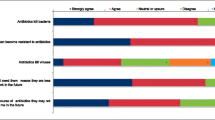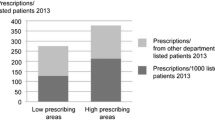Abstract
BACKGROUND
Overuse of antibiotics in the treatment of acute respiratory tract infection (ARI) contributes to the growing problem of antibiotic-resistant infections.
OBJECTIVE
To identify factors that influence community practitioners to prescribe antibiotics and examine how they differ from the recommendations of the Centers for Disease Control and Prevention (CDC) guideline for treatment of ARI.
DESIGN
Paper case vignette study using a fractional factorial design.
PARTICIPANTS
One hundred one community practitioners and eight faculty members.
MAIN MEASUREMENTS
We asked community practitioners to estimate how likely they would be to prescribe antibiotics in each of 20 cases of ARI and then used multiple regression to infer the importance weights of each of nine clinical findings. We then compared practitioners’ weights with those of a panel of eight faculty physicians who evaluated the cases following the CDC guidelines rather than their own judgments.
MAIN RESULTS
Practitioners prescribed antibiotics in 44.5% of cases, over twice the percentage treated by the panel using the CDC guidelines (20%). In deciding to prescribe antibiotic treatment, practitioners gave little or no weight to patient factors such as whether the patients wanted antibiotics. Although weighting patterns differed among practitioners, the majority (72%) gave the greatest weight to duration of illness. When illness duration was short, the rate of prescribing (20.1%) was the same as the rate of the faculty panel (20%).
CONCLUSIONS
Based on hypothetical cases of ARI, community practitioners prescribed antibiotics at twice the rate of faculty following CDC practice guidelines. Practitioners were most strongly influenced by duration of illness. The effect of duration was strongest when accompanied by fever or productive cough, suggesting that these situations would be important areas for practitioner education and further clinical studies.

Similar content being viewed by others
References
Roumie CL, Halasa NB, Grijalva CG, Edwards KM, Zhu Y, Dittus RS, Griffin MR. Trends in antibiotic prescribing for adults in the United States-1995 to 2002. J Gen Intern Med. 2005;20:697–702.
Gonzales R, Barrett PH Jr, Crane LA, Steiner JF. Factors associated with antibiotic use for acute bronchitis. J Gen Intern Med. 1998;13(8)541–8. Aug.
Gonzales R, Barrett PH, Steiner JF. The relation between purulent manifestations and antibiotic treatment of upper respiratory tract infections. J Gen Intern Med. 1999;14:151–6.
Macfarlane J, Holmes W, Macfarlane R, Britten N. Influence of patients’ expectations on antibiotic management of acute lower respiratory tract illness in general practice: questionnaire study. BMJ. 1997;315(7117)1211–4. Nov 8.
Scott JG, Cohen D, DiCicco-Bloom B, Orzano AJ, Jaen CR, Crabtree BF. Antibiotic use in acute respiratory infections and the ways patients pressure physicians for a prescription. J Fam Pract. 2001;50(10)853–8. Oct, Erratum in: J Fam Pract 2001 Dec;50(12):1077.
Steinman MA, Landefeld CS, Gonzales R. Predictors of broad-spectrum antibiotic prescribing for acute respiratory tract infections in adult primary care. JAMA. 2003;289:719–25.
Little DR, Mann PL, Godbout CJ. How family physicians distinguish acute sinusitis from upper respiratory tract infection: a retrospective analysis. J Am Board Fam Pract. 2000;13:101–6.
Williams JW, Simel DL. Does this patient have sinusitis? Diagnosing acute sinusitis by history and physical examination. JAMA. 1993;270:1242–6.
Dosh SA, Hickner JM, Mainous AG, Ebell MH. Predictors of antibiotic prescribing for nonspecific upper respiratory infections, acute bronchitis, and acute sinusitis. An UPRNet study. Upper Peninsula Research Network. J Fam Pract. 2000;49(5)407–14. May.
Sorum PC, Stewart TR, Mullet E, et al. Does choosing a treatment depend on making a diagnosis? US and French physicians’ decision making about acute otitis media. Med Decis Making. 2002;22(5)394–402. Sep-Oct.
Wigton RS, Poses RM, Collins M, Cebul RD. Teaching old dogs new tricks: using cognitive feedback to improve physicians’ diagnostic judgments on simulated cases. Acad Med. 1990;65(9)S5–6.
Gonzalez-Vallejo C, Sorum PC, Stewart TR, Chessare JB, Mumpower JL. Physicians’ diagnostic judgments and treatment decisions for acute otitis media in children. Med Decis. 12.
Murray S, Del Mar C, O’Rourke P. Predictors of an antibiotic prescription by GP’s for respiratory tract infections: a pilot. Fam Pract. 2000;17:386–8.
Linder JA, Singer DE. Desire for antibiotics and antibiotic prescribing for adults with upper respiratory tract infections. J Gen Intern Med. 2003;18(10)795–801. Oct.
Butler CC, Rollnick S, Pill R, Maggs-Rapport F, Stott N. Understanding the culture of prescribing: qualitative study of general practitioners’ and patients’ perceptions of antibiotics for sore throats. BMJ. 1998;317(7159)637–42. Sep 5.
Avorn J, Soumerai SB. Improving drug-therapy decisions through educational outreach. A randomized controlled trial of academically based “detailing”. N Engl J Med. 1983;308:1457–63.
Plackett RL, Burman JP. The design of optimum multifactorial experiments. Biometrika. 1946;33:305–25.
Gonzales R, Corbett KK, Leeman-Castillo BA, et al. The “minimizing antibiotic resistance in Colorado” project: impact of patient education in improving antibiotic use in private office practices. Health Serv Res. 2005;40(1)101–16. Feb.
Gonzales R, Bartlett JG, Besser RE, et al. Principles of appropriate antibiotic use for treatment of acute respiratory tract infections in adults: background, specific aims, and methods. Ann Intern Med. 2001;134(6)479–86. Mar 20.
Gonzales R, Bartlett JG, Besser RE, et al. Principles of appropriate antibiotic use for treatment of uncomplicated acute bronchitis: background. Ann Intern Med. 2001;134(6)521–9. Mar 20.
Hickner JM, Bartlett JG, Besser RE, et al. Principles of appropriate antibiotic use for acute rhinosinusitis in adults: background. Ann Intern Med. 2001;134(6)498–505. Mar 20.
Cooksey RW. Judgment Analysis: Theory, Methods, and Applications. Academic Press; 1996.
Wigton RS. Use of linear models to analyze physicians’ decisions. Journal of Medical Decision Making. 1988;8:241–52.
Ward JI, Cherry JD, Chang SJ, et al. Efficacy of an acellular pertussis vaccine among adolescents and adults. N Engl J Med. 2005;353(15)1555–63. Oct 13.
Heckerling PS, Tape TG, Wigton RS, et al. Clinical prediction rule for pulmonary infiltrates. Ann Intern Med. 1990;113:664–70.
Metlay JP, Kapoor WN, Fine MJ. Does this patient have community-acquired pneumonia? Diagnosing pneumonia by history and physical examination. JAMA. 1997;278(17)1440–5. Nov 5.
Diehr P, Wood RW, Bushyhead J, Krueger L, Wolcott B, Tompkins RK. Prediction of pneumonia in outpatients with acute cough-a statistical approach. J Chronic Dis. 1984;37(3)215–25.
Wenzel RP, Fowler AA. Clinical practice. Acute bronchitis. N Engl J Med. 2006;355(20)2125–30. 16.
Braman SS. Chronic cough due to chronic bronchitis: ACCP evidence-based clinical practice guidelines. Chest. 2006;129(1 Suppl)104S–15S.
Kirwan JR, Chaput de Saintonge DM, Joyce CRB, Holmes J, Currey HLF. Inability of rheumatologists to describe their true policies for assessing rheumatoid arthritis. Ann Rheum Dis. 1986;45:156–61.
Bradley CP. Uncomfortable prescribing decisions: a critical incident study. BMJ. 1992;304(6822)294–6. PMID: 1739831, Feb 1.
Acknowledgments
Parts of this study were presented at the 2002 Annual Meeting of the Society of General Internal Medicine.
The study was funded through grants and contracts from the Agency for Health Care Research and Quality. Minimizing Antibiotic Resistance in Colorado (MARC) Project (AHRQ R01 HS13001–01), a study testing different types of community educational campaigns to improve appropriate antibiotic use for ARIs18.
The funding source had no role in the design, conduct, and analysis of the study or in the decision to submit the manuscript for publication. Drs. Gonzales, Darr, Corbett, and Nickol had full access to the data.
The authors would like to thank Thomas Tape, MD, for his review and comments on this manuscript.
Conflict of Interest
None disclosed.
Author information
Authors and Affiliations
Corresponding author
Appendix
Appendix
Sample Case
This patient has the following history:
-
colored nasal drainage
-
no cough
-
no sinus symptoms
-
The patient has had this illness for 14 days
-
Feels this illness is so severe that treatment is needed
Examination:
-
temperature = 99° F
The patient has come in specifically to get antibiotic treatment
Patient is leaving on vacation soon and worries about the illness getting worse
No prior antibiotics for this sort of illness
-
1.
Mark an “x” on the line below to indicate how likely you are to prescribe an antibiotic in this case

-
2.
In your practice, would you prescribe an antibiotic for this patient? (Circle one) Yes No
-
3.
Mark an “x” on the line to indicate how comfortable you are with your decision about antibiotics?

-
4.
Imagine this same patient does not want to take antibiotics: Mark an “x” on the line to indicate how strongly you would urge the patient to start antibiotics right away.

Rights and permissions
About this article
Cite this article
Wigton, R.S., Darr, C.A., Corbett, K.K. et al. How Do Community Practitioners Decide Whether to Prescribe Antibiotics for Acute Respiratory Tract Infections?. J GEN INTERN MED 23, 1615–1620 (2008). https://doi.org/10.1007/s11606-008-0707-9
Received:
Revised:
Accepted:
Published:
Issue Date:
DOI: https://doi.org/10.1007/s11606-008-0707-9







